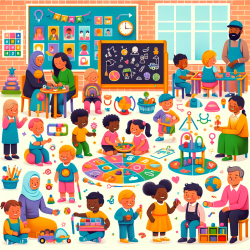The transition to kindergarten is a significant milestone for any child, but it can be especially challenging for children with disabilities. As a practitioner, it's essential to utilize evidence-based strategies to ensure a smooth and successful transition. The research article, "A Successful Kindergarten Transition for Children with Disabilities: Collaboration Throughout the Process," provides valuable insights and practical recommendations that can enhance your practice.
The Importance of Collaboration
Collaboration between preschool and kindergarten staff, as well as with families, is crucial for a successful transition. Here are some key practices to consider:
- Establish Communication Early: Begin discussing the transition process with families well before the end of the preschool year. This helps in setting clear expectations and addressing any concerns.
- Plan Individualized Transition Meetings: Organize meetings that include all relevant stakeholders, such as preschool teachers, kindergarten teachers, special education staff, and the child’s family. These meetings should focus on the child's unique needs and strengths.
- Use High-Intensity Transition Practices: Implement individualized practices such as home visits, personalized phone calls, and planning meetings. These practices are more effective than low-intensity ones like general information handouts.
Strategies for a Smooth Transition
The article emphasizes several strategies that can be implemented before, during, and after the transition to kindergarten:
- Before Transition: Arrange classroom visits for the child and their family to familiarize them with the new environment. Use visual aids like social stories to help the child understand what to expect.
- During Transition: Maintain open communication with the family and provide consistent support. Designate a primary contact person for the family to ensure continuity and address any issues promptly.
- After Transition: Continue to monitor the child's progress and hold follow-up meetings to discuss any adjustments needed. Collect data on the child’s adaptation to the new setting and make necessary modifications to the transition plan.
Encouraging Further Research
While the strategies mentioned are effective, it's important to continue researching and understanding the best practices for supporting children with disabilities during transitions. Areas for further research include:
- Identifying barriers to the use of high-intensity transition practices and finding ways to overcome them.
- Exploring the impact of technology on enhancing transition practices, especially in light of challenges posed by COVID-19.
- Determining which high-intensity transition practices have the most significant impact on positive child and family outcomes.
Conclusion
Supporting children with disabilities during their transition to kindergarten requires thoughtful planning, collaboration, and ongoing communication. By implementing high-intensity, individualized transition practices, practitioners can help ensure a smoother and more successful transition for these children and their families.To read the original research paper, please follow this link:
A Successful Kindergarten Transition for Children with Disabilities: Collaboration Throughout the Process.










